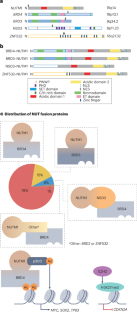隐藏在显而易见的:坚果癌是一种未被识别的肺和头颈部鳞状细胞癌亚型
IF 82.2
1区 医学
Q1 ONCOLOGY
引用次数: 0
摘要
在过去的二十年中,非小细胞肺癌(nsclc)和头颈部鳞状细胞癌(HNSCC)的治疗取得了相当大的进展,这主要是由于不同肿瘤亚型的特征,针对每种亚型的靶向治疗的发展以及免疫治疗的出现。过去二十年出现的数据表明,基于转录、组织病理学、细胞起源和分子特征,NUT癌是一种高度侵袭性的恶性肿瘤,由NUT融合癌蛋白驱动,发生在肺部、头部和颈部,很少发生在其他部位。NUT癌在美国的发病率估计为每年1400例,超过了一些罕见的NSCLC和HNSCC亚型。然而,NUT癌目前不被认为是肺或头颈部的鳞状细胞癌。尽管早期诊断对于这种中位生存期仅为6.5个月的癌症类型至关重要,但NUT癌作为一种独特实体的孤儿分类导致肿瘤学家和外科医生缺乏对这种恶性肿瘤的认识。因此,NUT癌被低估并经常误诊,导致在开发有效治疗肺癌和头颈癌最具侵袭性的形式之一方面的研究和进展有限。随着越来越多的靶向药物可能用于治疗NUT癌,通过将NUT癌重新分类并纳入这些部位的鳞状NSCLC或HNSCC来提高认可度,将加速这种疾病有效治疗方法的开发。因此,在展望中,我们建议将NUT癌重新分类为鳞状细胞癌,并讨论支持证据。本文章由计算机程序翻译,如有差异,请以英文原文为准。


Hiding in plain sight: NUT carcinoma is an unrecognized subtype of squamous cell carcinoma of the lungs and head and neck
In the past two decades, treatment for non-small-cell lung cancers (NSCLCs) and head and neck squamous cell carcinoma (HNSCC) has advanced considerably, owing largely to the characterization of distinct oncological subtypes, the development of targeted therapies for each subtype and the advent of immunotherapy. Data emerging over the past two decades suggest that NUT carcinoma, a highly aggressive malignancy driven by a NUT fusion oncoprotein and arising in the lungs, head and neck, and rarely in other sites, is a squamous cell carcinoma (SCC) based on transcriptional, histopathological, cell-of-origin and molecular characteristics. NUT carcinoma has an estimated incidence of 1,400 cases per year in the United States, surpassing that of some rare NSCLC and HNSCC subtypes. However, NUT carcinoma is currently not recognized as an SCC of the lungs or head and neck. The orphan classification of NUT carcinoma as a distinct entity leads to a lack of awareness of this malignancy among oncologists and surgeons, despite early diagnosis being crucial for this cancer type with a median survival of only ~6.5 months. Consequently, NUT carcinoma is underdiagnosed and often misdiagnosed, resulting in limited research and progress in developing effective treatments in one of the most aggressive forms of lung and head and neck cancer. With a growing number of targeted agents that can potentially be used to treat NUT carcinoma, improved recognition through reclassification and inclusion of NUT carcinoma as a squamous NSCLC or an HNSCC when arising in these locations will accelerate the development of effective therapies for this disease. Thus, in the Perspective, we propose such a reclassification of NUT carcinoma as an SCC and discuss the supporting evidence. Accumulating evidence indicates that NUT carcinoma, a highly aggressive malignancy driven by NUTM1 fusions, is a rare form of squamous cell carcinoma (SCC) of the lung or head and neck, calling into question its current classification as an entirely distinct disease entity. In this Perspective, the authors propose the reclassification of NUT carcinoma as an SCC, the supporting rationale, and the immediate implications for clinical practice and research
求助全文
通过发布文献求助,成功后即可免费获取论文全文。
去求助
来源期刊
CiteScore
99.40
自引率
0.40%
发文量
114
审稿时长
6-12 weeks
期刊介绍:
Nature Reviews publishes clinical content authored by internationally renowned clinical academics and researchers, catering to readers in the medical sciences at postgraduate levels and beyond. Although targeted at practicing doctors, researchers, and academics within specific specialties, the aim is to ensure accessibility for readers across various medical disciplines. The journal features in-depth Reviews offering authoritative and current information, contextualizing topics within the history and development of a field. Perspectives, News & Views articles, and the Research Highlights section provide topical discussions, opinions, and filtered primary research from diverse medical journals.

 求助内容:
求助内容: 应助结果提醒方式:
应助结果提醒方式:


